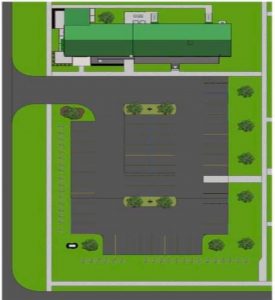FCRA director touts $1.751 billion in investments since 2000
by June 18, 2020 6:28 pm 910 views

Since the Fort Chaffee Redevelopment Authority began tracking activity in 2000, there has been $1.751 billion capital investments turning the former Army base into Chaffee Crossing, according to Daniel Mann, FCRA executive director and CEO.
That number included investments made through Dec. 31. Mann also said in 2019, FCRA invested $1.267 million back into the project. Revenue earned from land sales and leases along with a reduction in overhead expenses, led the authority to end the year with net profit of just over $500,000 Mann said. In 2018, it had a $700,000 net loss.
“That’s a really great turn around. And it shows how we have been able to make the investment back into Chaffee Crossing,” Mann said during the FCRA board meeting Thursday (June 18).
He also noted that FCRA recently sent the state a check for $1 million, half of its obligation for the Arkansas Highway 255 Relocation project. The Arkansas Department of Transportation (ARDOT) began letting contracts for the project in May. FCRA, Barling and Fort Smith entered into a multi-party agreement with ARDOT on this project in 2017, Mann said. As part of that agreement, FCRA had to commit $2 million toward the construction of this project.
The largest investments in Chaffee Crossing in 2019 are in the health-related field, Mann said, thanks in part to the $23 million Mercy Rehabilitation Hospital located at Chaffee Crossing. Mercy broke ground on the 52,967-square-foot hospital, which is next to the Arkansas College of Osteopathic Medicine on the ACHE campus and will serve as a teaching site for students in ACHE’s School of Occupational Therapy and School of Physical Therapy, Feb. 12.
Mann also told the board FCRA had closed on a building at 7308 Ellis St. in the historical district. Lloyd Sumpter with Rival CRE purchased the building and will turn it into commercial and retail space, which fits in with the planned zoning district (PZD) recently passed by the FCRA board and Fort Smith Board of Directors. The historic/mixed use designation allows for restaurants, retail and office space and residential dwellings among other uses, but would not allow for warehouses, Mann said. The PZD provides all properties inside the boundary a single set of zoning guidelines and end-uses, which will make it easier and faster for business owners to get building permits from the city of Fort Smith, Mann said.
“We were able to close on this property in a great part because of that new PZD,” he said.

Sumpter said the building will be divided into three parts, two of which have already been leased to a salon and a do-it-yourself art studio. The third section, which has not been leased, has been renovated with a covered outdoor patio area designed specifically for a restaurant.
The design aspect of the building will be similar to property Sumpter completed in 2019 next door that now house Primetime Barbershop and Seiter Designs, he said. Sumpter has two more properties under contract that will make up the remainder of the buildings on the corner of Ellis and Ward streets. Those will be the first of the two-story barracks in the historic district to be sold, Mann said.
Sumpter’s plans call for having commercial and retail in the first story with residential living space on the second floor. Sumpter said because of regulations, he cannot close on those properties until lead-based paint issues have been fixed.
The board meeting was the first since former Executive Director Ivy Owen, who served as the face and often evangelical voice of the Fort Chaffee Redevelopment Authority (FCRA) for many years, died June 5 at the age of 73. No mention of Owen’s death was made at the meeting.
“We put out a statement when Ivy died, and we stand by that,” Mann said. “Ivy did a lot for Chaffee Crossing over many years. We had a very good relationship over the past six years when I was in Kansas. I watched from afar what he’d done, and now I’m happy to be able to add to it.”
